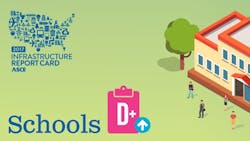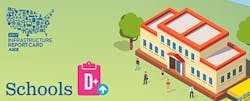America's school facilities get a D+ from civil engineers group
Nearly one-quarter of the nation's public school buildings are in fair or poor condition, the American Society of Civil Engineers (ASCE) says.
The subpar conditions in many schools combined with the lack of money allocated to address facility needs have resulted in the ASCE's decision to give schools a D-plus grade in the organization's 2017 Infrastructure Report Card.
The D-plus is a slight improvement on the grade that schools received in the previous report card. In 2013, schools received a D.
The numbers cited by the ASCE spell out where schools are falling behind in upkeep of its facilities. An assessment of public school buildings found that 24 percent were rated in "fair" or "poor" conditions. Among schools that have some temporary buildings, 45 percent are in fair or poor condition. In addition, 36 percent of school parking lots, 32 percent of bus lanes, 31 percent of athletic facilities, and 27 percent of playgrounds are in fair or poor condition.
Too many schools do not have a systematic approach to deal with the facility needs, the report asserts.
"Four in 10 public schools do not have a long-term educational facilities plan in place to address operations and maintenance," the ASCE says. "The main reason for repair, renovation, or modernization work on school facilities relates to improving energy efficiency as well as technology infrastructure."
Schools districts in the aggregate spent $49 billion a year from 2011 to 2013 for new facilities and capital construction, but studies have estimated that the nation as a whole should be spending $87 billion a year to provide safe, healthful, modern learning environments.
Funding that was in place before the 2008 recession was reduced when the economy collapsed, but in many states the cuts have not been restored and spending levels are below what they were in 2008.
"Facing tight budgets, school districts' ability to fund maintenance has been constricted, contributing to the accelerating deterioration of heating, cooling, and lighting systems," the ASCE says. "Deferred maintenance and decisions to choose les expensive temporary fixes are ultimately costing school districts more money in the long term."
To raise schools' grade above a D-plus, the report card includes several recommendations:
- Governments at every level should regularly assess the needs of their public school facilities and publish the data.
- Continue to encourage school districts to adopt regular, comprehensive major maintenance, renewal, and construction programs, and establish preventative maintenance programs to extend the life of school facilities.
- Expand federal and state tax credits and matching funds to support increased use of school construction bonds and simplify the process for local school districts to obtain facility construction financing for improvements and modernizations.
- Explore alternative financing, including lease financing, as well as ownership and use arrangements, to facilitate school construction projects.
- Develop capital planning frameworks that can be nimble and responsive to changing technologies and changing demographics, to optimize learning environments and consider the holistic needs of the community.
About the Author
Mike Kennedy
Senior Editor
Mike Kennedy, senior editor, has written for AS&U on a wide range of educational issues since 1999.

